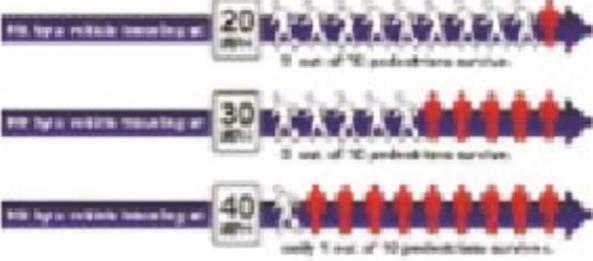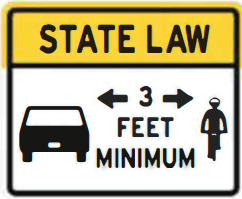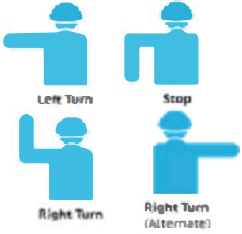
All Locations Closed for Thanksgiving
All locations are closed Thurs & Fri Nov 27th & 28th
Section 9 Continued
Crosswalks
Crosswalks exist on all four corners of intersections even when they are not marked by painted lines. A crosswalk is the part of the pavement for pedestrian traffic where the sidewalk would extend across the street. Crosswalks can also exist mid-block if they are marked.
Respect Crosswalks
When pedestrians are in crosswalks, they have the right of way over motor vehicles. Do not block crosswalks. When stopping at red lights or stop signs, always stop your vehicle before the crosswalk so pedestrians can cross safely.
Even at crosswalks without traffic signals, drivers must stop and remain stopped for pedestrians in the crosswalk when the pedestrian is upon the half of the roadway or approaching and within one lane of the half of the roadway upon which the vehicle is traveling. "Half of the roadway" means all traffic lanes carrying traffic in one direction of travel.
Blind Pedestrians
Pedestrians using guide dogs or white walking canes must be given the right of way at all times.
Always Remain Alert for Pedestrians When Driving
Look for pedestrians on both sides of the street when approaching intersections, when turning, or near schools, parks, bus stops and other places people are likely to walk. Look behind your car for children or other pedestrians before backing up in driveways and parking lots.
Turning Right at a Red Traffic Signal
Before turning right on red, drivers must come to a full and complete stop before the crosswalk. Do not block the crosswalk when waiting to make a right turn at a red light. This puts pedestrians at risk, forcing them to walk around your vehicle. After looking to your left to find a gap in traffic, you must look to your passenger side to ensure a pedestrian is not crossing in front of your vehicle.
Passing Stopped Cars in Lanes of Travel
Use extreme caution when passing stopped cars on multi-lane roads. A pedestrian you can't see may be crossing in a marked or unmarked crosswalk. This is a frequent cause of serious or fatal pedestrian injuries. When you stop at a crosswalk on a multi-lane road, stop at least 10 feet before the crosswalk so a driver in the next lane can see the pedestrian.
Exiting and Entering Driveways
When exiting or entering a driveway, alley, or parking garage, drivers must stop before the sidewalk area and proceed only after pedestrians have safely passed. Drivers waiting to turn left into a driveway must wait not only for a gap in oncoming traffic, but also for pedestrians to finish crossing the sidewalk portion of the driveway.
Vehicle Speed
Pedestrians are less protected from the harmful effects of a crash than occupants of motor vehicles. The risk of serious or fatal pedestrian injuries increase exponentially with driver speed.
The chart titled "Vehicle speed" illustrates the effect of speed upon a pedestrian who is struck by a motor vehicle. When a pedestrian is struck by a motor vehicle traveling 40mph, the risk of pedestrian death is at least 80%.
Vehicle Speed chart

Sharing the Road With Bicycles
Bicycle riding is an important type of transportation, particularly for traveling to work and to school. Because bicyclists may be on any road at any time, drivers must always be alert for bicycle traffic.
Bike-car crashes often happen because drivers do not see bicyclists soon enough. In Georgia, as in other states, most crashes occur during daylight hours on straight, dry roads, typically near intersections or driveways.
Bicyclists are legally entitled to use every road in Georgia except the interstate and interstate-like highways (limited access highways). The law allows bicyclists use of the full lane. They are not required to be in a bike lane even when one is present. Although their slower pace may slow motorists occasionally, it is important for drivers to respect the bicyclist's right to be there. Yield the right of way to the bicyclist in the same way that you would yield to another motorist. If possible, make eye contact with the bicyclist, especially at intersections.
Road defects cause more problems for bicycles than for cars. When passing a bicycle rider, leave the bicyclist plenty of room in case he or she has to swerve to miss a pothole or other danger in the road. The minimum legal space for a motorist to pass a bicyclist is 3 feet.
Important Reminders Concerning Bicycle Riders

Motorists should approach bicycles with due caution and shall proceed as follows: (Violation is a misdemeanor punishable by a fine up to $250.00).
Make a lane change into a lane not adjacent to the bicycle if possible in the existing road and traffic conditions OR
If a lane change is impossible, prohibited by law, or unsafe, reduce the speed of the motor vehicle to a reasonable and proper speed for the traffic conditions, which speed shall be at least ten miles per hour less than the posted speed limit or 25 miles per hour, whichever is more and proceed around the bicycle with at least three feet between the vehicle and the bicycle at all times.
- Watch for bicyclists who may appear to suddenly swerve or turn in front of you. Bicyclists sometimes forget or do not have the opportunity to merge left due to traffic speed, in order to be in the left turn position.
- Night time bicyclists will not always have lights, and some may not even have reflectors. If you meet an oncoming bicyclist, please dim your lights to avoid blinding the bicyclist.
- Bike lanes and any other bicycle infrastructure are for the use of bicycles only. Motorists are not to drive or park in a bike lane.
- Bicyclists are able to pass on the right side of motorists if there is a dedicated lane or sufficient room in a shared lane, and it is safe to do so.
Arm Signals Used by Bicyclists
Bicyclists should use their arms to signal to other motorists when they are going to make a turn, and the direction of the turn or when they are slowing or stopping. The signals used by bicyclists are listed in the image titled "Bicyclist Arm Signals".
Bicyclist Arm Signals

Sharing the Road With Motorcycles
Today's motorcycle riders are friends, relatives, and neighbors, but many car drivers still have not adjusted to motorcycles appearing in traffic. Traveling by motorcycle is appealing to some people; they are fuel and space efficient and can be fun to ride. Motorcyclists have the same rights and responsibilities as automobile drivers. While everyone must follow the same traffic laws, motorcyclists face additional dangers because motorcycles require exceptional handling ability and motorcyclists are more vulnerable to injury and death than car drivers if involved in a crash. It is important to understand more about motorcycle operation.
From ahead or behind, a motorcycle's outline, whether 2 or 3 wheels, is much smaller than a passenger vehicle's outline, and most drivers expect to see larger vehicles on the road and are not looking for motorcycles. The small profile of the motorcycle may make it appear farther away and traveling slower than it actually is. Drivers need to take a second look, and then a third. Always make a visual check (mirrors, too) of blind spots before entering or leaving a lane of traffic and at intersections. Be alert for a motorcyclist to appear unexpectedly.
Allow a Full Lane
Motorcycles are allowed the full width of a lane in which to maneuver. Although it may seem that there is enough room in the traffic lane for a motor vehicle and a motorcycle, the motorcycle needs the room to maneuver safely. Do not share the lane. Understand that motorcyclists may adjust lane position for their own safety, not to be reckless or show off. Motorcyclists often adjust position within a lane to be seen more easily or to minimize the effects of road debris, passing vehicles, or other conditions. Often, this means riding in the left portion of the traffic lane to allow a better view of some traffic and road situations. It also makes the motorcycle more visible to other traffic. However, as traffic and road conditions change, the rider may move. This move could be to the center of the lane or even to the right side to avoid traffic or to be seen by others on the road.
Road Conditions
Remember that road conditions which are minor annoyances to motorists can pose major hazards to motorcyclists. Motorcycle riders may change speed or adjust position within a lane suddenly in reaction to road and traffic conditions such as potholes, gravel, wet or slippery surfaces, pavement seams, railroad crossings, and grooved pavement.
Intersections
Intersections are the most likely places for car/motorcycle crash to occur. This usually is the result of a car driver NOT SEEING the motorcycle and turning into the motorcycle's path. Misinterpreting a rider's intentions can also lead to crashes. The rider will move to one side of the lane in preparation for a turn or possibly to move away from a hazard unseen by other motorists. Do not assume the rider's intention until the maneuver is unmistakably started, such as a turn into an intersection or driveway. Don't be fooled by a flashing turn signal on a motorcycle – motorcycle signals may not be self-canceling and motorcyclists sometimes forget to turn them off. Wait to be sure the rider is going to turn before you proceed.
Following Too Close
Allow more following distance -- three or four seconds - when following a motorcycle so the motorcycle rider has enough time to maneuver or stop in an emergency. Space between the two vehicles should be increased to avoid sudden braking. In dry conditions, motorcycles can stop more quickly than cars. Both riders and drivers are more likely to make incorrect decisions if there is not enough stopping distance or ability to see and react to conditions. This leads to crashes. A rider's chance of injury is greater if forced to avoid obstacles ahead, as well as a driver following too closely.
Passing and Being Passed
The rules for passing other vehicles are similar for motorcycles. The motorist being overtaken by a motorcycle should maintain lane position and speed. Allow the motorcyclist to complete the pass and assume proper lane position as quickly as possible. When passing a motorcycle, allow a full lane to the motorcycle. Never crowd into the same lane as the motorcycle. Returning to the original lane too soon can force a rider to swerve to the right into traffic or off the road.
Partners on the Road
What all this means is, motorcycles are full partners in the traffic mix and must be treated with the same courtesies. Watch for the unexpected and give them their share of the road; a rider may be the neighbor next door.